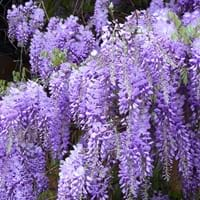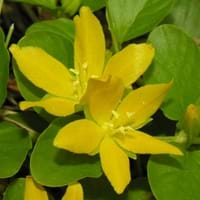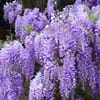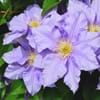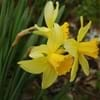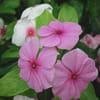Life Span
Perennial
Perennial
Type
Flowering Plants
Flowering Plants, Perennial
Origin
China, Eastern United States, Japan, Korea
Europe
Types
Chinese Wisteria, Japanese wisteria, Silky wisteria, American wisteria
creeping jenny
Number of Varieties
Not Available
Habitat
Forest edges, River side
Near ponds, River side, Wet ground
USDA Hardiness Zone
5-9
4-8
Sunset Zone
2a, 2b, 3a, 3b, 4, 5, 6, 7, 8, 9, 10, 11, 13, 14, 15, 16, 17, 18, 19, 20, 21, 22, 23, 24
1a, 1b, 2a, 2b, 3a, 3b, 4, 5, 6, 7, 8, 9, 14, 15, 16, 17, 18, 19, 20, 21, 22, 23, 24
Habit
Vine/Liana
Spreading
Flower Color
Pink, Purple, Violet
Yellow
Flower Color Modifier
Not Available
Bicolor
Fruit Color
Not Available
Not Available
Leaf Color in Spring
Green
Green
Leaf Color in Summer
Green
Green
Leaf Color in Fall
Green
Green
Leaf Color in Winter
Not Available
Light Green
Plant Season
Spring
Spring, Summer, Fall
Sunlight
Full Sun
Full Sun, Partial Sun, Partial shade, Full Shade
Type of Soil
Clay, Loamy, Sandy
Clay, Loam
The pH of Soil
Neutral, Slightly Acidic, Slightly Alkaline
Acidic, Neutral
Soil Drainage
Well drained
Average
Bloom Time
Mid Spring
Late Spring, Early Summer
Tolerances
Not Available
Drought
Where to Plant?
Ground, Pot
Container, Ground, Pot
How to Plant?
Seedlings
Stem Planting
Plant Maintenance
Medium
Medium
Watering Requirements
Water in morning to avoid prompting diseases, when new, water every week
Requires a lot of watering, Requires regular watering
In Summer
Lots of watering
Lots of watering
In Spring
Moderate
Moderate
In Winter
Average Water
Average Water
Soil pH
Neutral, Slightly Acidic, Slightly Alkaline
Acidic, Neutral
Soil Type
Clay, Loamy, Sandy
Clay, Loam
Soil Drainage Capacity
Well drained
Average
Sun Exposure
Full Sun
Full Sun, Partial Sun, Partial shade, Full Shade
Pruning
Cut or pinch the stems, No pruning needed in the early stages, Prune twice a year, Remove dead or diseased plant parts, Remove deadheads
Remove damaged leaves, Remove dead branches, Remove dead leaves
Fertilizers
All-Purpose Liquid Fertilizer
All-Purpose Liquid Fertilizer
Pests and Diseases
Aphids, Canker, Crown gall, Leaf spot, Mealybugs, Powdery mildew, Root rot, Scale
Pests and diseases free
Plant Tolerance
Drought
Drought
Flower Petal Number
Single
Single
Foliage Texture
Coarse
Medium
Foliage Sheen
Not Available
Glossy
Attracts
Flying insects
Not Available
Aesthetic Uses
Showy Purposes
Beautification, Bouquets, Used for decorating walls, fences, gates, hedges, etc.
Beauty Benefits
Not Available
Not Available
Environmental Uses
Air purification
Provides ground cover
Medicinal Uses
Not Available
Diarrhea
Part of Plant Used
Flowers, Seeds
Flowers, Leaves
Other Uses
Sometimes used for making wine
Used as Ornamental plant
Used As Indoor Plant
No
No
Used As Outdoor Plant
Yes
Yes
Garden Design
Shady Tree, Showy Tree, Street Trees
Container, Edging, Groundcover, Hanging Basket, Mixed Border, Water Gardens
Botanical Name
Wisteria
LYSIMACHIA nummularia 'Goldilocks'
Common Name
Wisteria
Creeping jenny, moneywort, herb twopence and twopenny thot
In Hindi
Wisteria
Lysimachia Nummularia
In German
Glyzinien
Lysimachia Nummularia
In French
Glycines
Lysimaque nummulaire
In Spanish
Glicinas
Lysimachia nummularia
In Greek
γλυκίνη
Λυσιμαχία nummularia
In Portuguese
Glicínias
Lysimachia nummularia
In Polish
Wisteria
tojeść rozesłana
In Latin
Wisteria
Lysimachiam nummularia
Phylum
Anthophyta
Tracheophyta
Class
Dicotyledonae
Magnoliopsida
Family
Fabaceae
Primulaceae
Genus
Wisteria
Lysimachia
Clade
Not Available
Angiosperms, Asterids, Eudicots
Tribe
Millettieae
Not Available
Subfamily
Faboideae
Not Available
Number of Species
Not Available
Importance of Wisteria and Lysimachia Nummularia
Want to have the most appropriate plant for your garden? You might want to know the importance of Wisteria and Lysimachia Nummularia. Basically, these two plants vary in many aspects. Compare Wisteria and Lysimachia Nummularia as they differ in many characteristics such as their life, care, benefits, facts, etc. Every gardener must at least have the slightest clue about the plants he wants to plant in his garden. Compare their benefits, which differ in many ways like facts and uses. The medicinal use of Wisteria is Not Available whereas of Lysimachia Nummularia is Diarrhea. Wisteria has beauty benefits as follows: Not Available while Lysimachia Nummularia has beauty benefits as follows: Not Available.
Compare Facts of Wisteria vs Lysimachia Nummularia
How to choose the best garden plant for your garden depending upon its facts? Here garden plant comparison will help you to solve this query. Compare the facts of Wisteria vs Lysimachia Nummularia and know which one to choose. As garden plants have benefits and other uses, allergy is also a major drawback of plants for some people. Allergic reactions of Wisteria are Itchiness whereas of Lysimachia Nummularia have Asthma respectively. Having a fruit bearing plant in your garden can be a plus point of your garden. Wisteria has showy fruits and Lysimachia Nummularia has no showy fruits. Also Wisteria is flowering and Lysimachia Nummularia is flowering. You can compare Wisteria and Lysimachia Nummularia facts and facts of other plants too.
